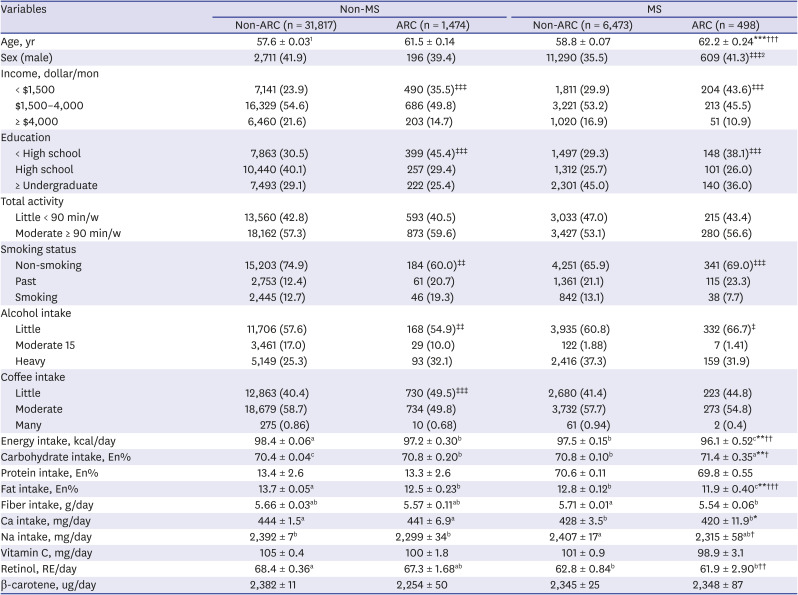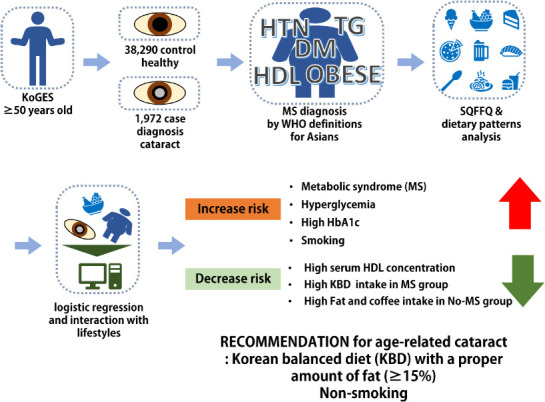1. Lee CM, Afshari NA. The global state of cataract blindness. Curr Opin Ophthalmol. 2017; 28(1):98–103. PMID:
27820750.

2. Prokofyeva E, Wegener A, Zrenner E. Cataract prevalence and prevention in Europe: a literature review. Acta Ophthalmol. 2013; 91(5):395–405. PMID:
22715900.

3. Rim TH, Kim MH, Kim WC, Kim TI, Kim EK. Cataract subtype risk factors identified from the Korea National Health and Nutrition Examination survey 2008–2010. BMC Ophthalmol. 2014; 14(1):4. PMID:
24410920.

4. Beebe DC, Holekamp NM, Shui YB. Oxidative damage and the prevention of age-related cataracts. Ophthalmic Res. 2010; 44(3):155–165. PMID:
20829639.

5. Liang YB, Friedman DS, Wong TY, Zhan SY, Sun LP, Wang JJ, et al. Prevalence and causes of low vision and blindness in a rural Chinese adult population: the Handan Eye Study. Ophthalmology. 2008; 115(11):1965–1972. PMID:
18684506.
6. Mundy KM, Nichols E, Lindsey J. Socioeconomic disparities in cataract prevalence, characteristics, and management. Semin Ophthalmol. 2016; 31(4):358–363. PMID:
27100947.

7. Nam GE, Han K, Ha SG, Han BD, Kim DH, Kim YH, et al. Relationship between socioeconomic and lifestyle factors and cataracts in Koreans: the Korea National Health and Nutrition Examination Survey 2008–2011. Eye (Lond). 2015; 29(7):913–920. PMID:
25976646.

8. Guo C, Wang Z, He P, Chen G, Zheng X. Prevalence, causes and social factors of visual impairment among Chinese adults: based on a national survey. Int J Environ Res Public Health. 2017; 14(9):E1034. PMID:
28885571.

9. Lindblad BE, Håkansson N, Philipson B, Wolk A. Alcohol consumption and risk of cataract extraction: a prospective cohort study of women. Ophthalmology. 2007; 114(4):680–685. PMID:
17173974.
10. Lu ZQ, Sun WH, Yan J, Jiang TX, Zhai SN, Li Y. Cigarette smoking, body mass index associated with the risks of age-related cataract in male patients in northeast China. Int J Ophthalmol. 2012; 5(3):317–322. PMID:
22773980.
11. Lindblad BE, Håkansson N, Wolk A. Smoking cessation and the risk of cataract: a prospective cohort study of cataract extraction among men. JAMA Ophthalmol. 2014; 132(3):253–257. PMID:
24385206.
12. Zheng Selin J, Rautiainen S, Lindblad BE, Morgenstern R, Wolk A. High-dose supplements of vitamins C and E, low-dose multivitamins, and the risk of age-related cataract: a population-based prospective cohort study of men. Am J Epidemiol. 2013; 177(6):548–555. PMID:
23420353.

13. Kim Y, Han BG. KoGES group. Cohort profile: the Korean Genome and Epidemiology Study (KoGES) consortium. Int J Epidemiol. 2017; 46(2):e20. PMID:
27085081.

14. Lim S, Jang HC, Lee HK, Kimm KC, Park C, Cho NH. A rural-urban comparison of the characteristics of the metabolic syndrome by gender in Korea: the Korean Health and Genome Study (KHGS). J Endocrinol Invest. 2006; 29(4):313–319. PMID:
16699297.

15. Liu M, Jin HS, Park S. Protein and fat intake interacts with the haplotype of PTPN11_rs11066325, RPH3A_rs886477, and OAS3_rs2072134 to modulate serum HDL concentrations in middle-aged people. Clin Nutr. 2020; 39(3):942–949. PMID:
31006500.

16. Kim Y, Han BG. KoGES group. Cohort profile: the Korean genome and epidemiology study (KoGES) consortium. Int J Epidemiol. 2017; 46(2):e20–20. PMID:
27085081.

17. Park S, Ham JO, Lee BK. Effects of total vitamin A, vitamin C, and fruit intake on risk for metabolic syndrome in Korean women and men. Nutrition. 2015; 31(1):111–118. PMID:
25466654.

18. Ahn Y, Kwon E, Shim JE, Park MK, Joo Y, Kimm K, et al. Validation and reproducibility of food frequency questionnaire for Korean genome epidemiologic study. Eur J Clin Nutr. 2007; 61(12):1435–1441. PMID:
17299477.

19. Steel RG, Torrie JH, Dickey DA. Principles and Procedures of Statistics: a Biological Approach. New York, NY, USA: McGraw-Hill;1997.
20. Kim JO, Mueller CW. Factor Analysis. Statistical Methods and Practical Issues. Thousand Oaks, CA, USA: Sage Publications;1978.
21. Park SJ, Lee JH, Kang SW, Hyon JY, Park KH. Cataract and cataract surgery: nationwide prevalence and clinical determinants. J Korean Med Sci. 2016; 31(6):963–971. PMID:
27247507.

22. Sabanayagam C, Wang JJ, Mitchell P, Tan AG, Tai ES, Aung T, et al. Metabolic syndrome components and age-related cataract: the Singapore Malay eye study. Invest Ophthalmol Vis Sci. 2011; 52(5):2397–2404. PMID:
21228391.

23. Park S, Kim T, Cho SI, Lee EH. Association between cataract and the degree of obesity. Optom Vis Sci. 2013; 90(9):1019–1027. PMID:
23811609.

24. Pizzol D, Veronese N, Quaglio G, Di Gennaro F, Deganello D, Stubbs B, et al. The association between diabetes and cataract among 42,469 community-dwelling adults in six low- and middle-income countries. Diabetes Res Clin Pract. 2019; 147:102–110. PMID:
30529577.

25. Becker C, Schneider C, Aballéa S, Bailey C, Bourne R, Jick S, et al. Cataract in patients with diabetes mellitus-incidence rates in the UK and risk factors. Eye (Lond). 2018; 32(6):1028–1035. PMID:
29386666.

26. Heydari B, Kazemi T, Zarban A, Ghahramani S. Correlation of cataract with serum lipids, glucose and antioxidant activities: a case-control study. West Indian Med J. 2012; 61(3):230–234. PMID:
23155978.

27. Li S, Li D, Zhang Y, Teng J, Shao M, Cao W. Association between serum lipids concentration and patients with age-related cataract in China: a cross-sectional, case-control study. BMJ Open. 2018; 8(4):e021496.

28. Yu X, Lyu D, Dong X, He J, Yao K. Hypertension and risk of cataract: a meta-analysis. PLoS One. 2014; 9(12):e114012. PMID:
25474403.

29. de Vries AC, Vermeer MA, Bloemendal H, Cohen LH. Pravastatin and simvastatin differently inhibit cholesterol biosynthesis in human lens. Invest Ophthalmol Vis Sci. 1993; 34(2):377–384. PMID:
8440592.
30. Stoll LL, McCormick ML, Denning GM, Weintraub NL. Antioxidant effects of statins. Drugs Today (Barc). 2004; 40(12):975–990. PMID:
15645009.

31. Hippisley-Cox J, Coupland C. Unintended effects of statins in men and women in England and Wales: population based cohort study using the QResearch database. BMJ. 2010; 340:c2197. PMID:
20488911.

32. Hermans MP, Ahn SA, Rousseau MF. Statin therapy and cataract in type 2 diabetes. Diabetes Metab. 2011; 37(2):139–143. PMID:
21145274.

33. Cheung N, Wong TY. Obesity and eye diseases. Surv Ophthalmol. 2007; 52(2):180–195. PMID:
17355856.

34. Tan JS, Wang JJ, Mitchell P. Influence of diabetes and cardiovascular disease on the long-term incidence of cataract: the Blue Mountains eye study. Ophthalmic Epidemiol. 2008; 15(5):317–327. PMID:
18850468.

35. Ghaem Maralani H, Tai BC, Wong TY, Tai ES, Li J, Wang JJ, et al. Metabolic syndrome and risk of age-related cataract over time: an analysis of interval-censored data using a random-effects model. Invest Ophthalmol Vis Sci. 2013; 54(1):641–646. PMID:
23258144.

36. Stevens VJ, Rouzer CA, Monnier VM, Cerami A. Diabetic cataract formation: potential role of glycosylation of lens crystallins. Proc Natl Acad Sci U S A. 1978; 75(6):2918–2922. PMID:
275862.

37. Pollreisz A, Schmidt-Erfurth U. Diabetic cataract-pathogenesis, epidemiology and treatment. J Ophthalmol. 2010; 2010:608751. PMID:
20634936.

38. Kinoshita JH. Pathways of glucose metabolism in the lens. Invest Ophthalmol. 1965; 4:619–628. PMID:
14340173.
39. Bunce GE, Kinoshita J, Horwitz J. Nutritional factors in cataract. Annu Rev Nutr. 1990; 10(1):233–254. PMID:
2200464.

40. Sedaghat F, Ghanavati M, Nezhad Hajian P, Hajishirazi S, Ehteshami M, Rashidkhani B. Nutrient patterns and risk of cataract: a case-control study. Int J Ophthalmol. 2017; 10(4):586–592. PMID:
28503432.

41. Ahn J, Kim NS, Lee BK, Park S. Carbohydrate intake exhibited a positive association with the risk of metabolic syndrome in both semi-quantitative food frequency questionnaires and 24-hour recall in women. J Korean Med Sci. 2017; 32(9):1474–1483. PMID:
28776343.

42. Park S, Ahn J, Lee BK. Very-low-fat diets may be associated with increased risk of metabolic syndrome in the adult population. Clin Nutr. 2016; 35(5):1159–1167. PMID:
26602244.

43. Park S, Ahn J, Kim NS, Lee BK. High carbohydrate diets are positively associated with the risk of metabolic syndrome irrespective to fatty acid composition in women: the KNHANES 2007–2014. Int J Food Sci Nutr. 2017; 68(4):479–487. PMID:
27822963.

44. Ahn J, Kim NS, Lee BK, Park S. Carbohydrate intake exhibited a positive association with the risk of metabolic syndrome in both semi-quantitative food frequency questionnaires and 24-hour recall in women. J Korean Med Sci. 2017; 32(9):1474–1483. PMID:
28776343.

45. Park S, Lee EH. Association between metabolic syndrome and age-related cataract. Int J Ophthalmol. 2015; 8(4):804–811. PMID:
26309883.









 PDF
PDF Citation
Citation Print
Print




 XML Download
XML Download